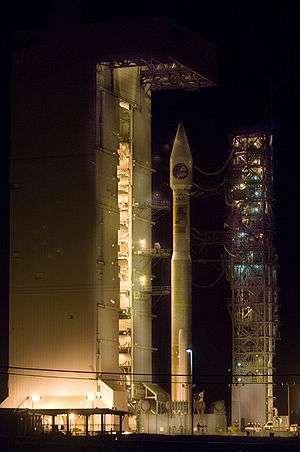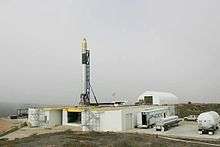Vandenberg AFB Space Launch Complex 3
 The first Atlas V to launch from the West Coast at SLC-3E. | |||||||||||||||||||||||||
| Launch site | Vandenberg AFB | ||||||||||||||||||||||||
|---|---|---|---|---|---|---|---|---|---|---|---|---|---|---|---|---|---|---|---|---|---|---|---|---|---|
| Location |
34.6423°N 120.5885°W | ||||||||||||||||||||||||
| Short name | SLC-3 | ||||||||||||||||||||||||
| Operator | US Air Force | ||||||||||||||||||||||||
| Total launches | 120 | ||||||||||||||||||||||||
| Launch pad(s) | 2 | ||||||||||||||||||||||||
| Min / max orbital inclination | 51° – 145° | ||||||||||||||||||||||||
| |||||||||||||||||||||||||
Space Launch Complex 3 (SLC-3) is a launch site at Vandenberg Air Force Base that has been used by Atlas and Thor rockets. It was built in the early 1960s and consists of two pads, SLC-3E (East) and SLC-3W (West). The East-West coastline at Vandenberg allows SLC-3 to launch over-ocean polar trajectories that avoid landfall until passing over Antarctica. By contrast, Cape Canaveral has a North-South coastline permitting over-ocean launches into standard orbits.
SLC-3E
Three successful Atlas IIAS missions were flown from SLC-3E. The first mission, flown on December 18, 1999, launched the Terra satellite.[1] The other two launched satellites in the Naval Ocean Surveillance System, USA 160 and USA 173.[2][3] The final Atlas IIAS mission from SLC-3E was launched on December 2, 2003.[4]
It was reported in 2003 that SLC-3E would be overhauled to serve as a launch platform for the Atlas V.[5] Renovations of SLC-3E, which began after a January 2004 ground breaking ceremony, included raising the Mobile Service Tower roof by approximately 30 ft (9.1 m), to a height of 239 ft (73 m). The tower can thus accommodate an Atlas V 500 series vehicle with its larger payload fairing.[6] In July 2004 Lockheed Martin announced the arrival of the fourth and final segment of the fixed launch platform (FLP). The segments had been transported from a fabrication facility in Oak Hill, FL, 3,500 miles (5,600 km) away. The largest segment weighed 90 tons and, "is thought to be the biggest over-the-road shipment ever attempted cross-country."[7] In February 2005 the activations team handed over the launch pad to the operational team, marking the end of major reconstruction.[8] The first Atlas V launch from SLC-3E took place at 10:02 GMT on March 13, 2008.[9]
SLC-3W

SLC-3W was originally built for Atlas-Agena launches and the first flight off the pad was the launch of Samos 1 in October 1960. The facility was extensively damaged 11 months later when Samos 3's booster exploded on the pad, but it was repaired quickly and hosted its next launch slightly under two months afterwards.
In 1962-63, the pad was converted for Thor-Agena use and was the primary launching site for Corona reconnaissance satellites for the next decade. After the Corona program ended in 1972, SLC-3W was converted back to support Atlases, this time flights of refurbished Atlas E/F missiles. The final such launch took place in 1995.
SpaceX initially planned to use SLC-3W for the Falcon 1 launch vehicle but switched to SLC-4E with Falcon 9.[10]
See also
| Wikimedia Commons has media related to Vandenberg AFB Space Launch Complex 3. |
- Canyon Fire - A 2016 wildfire that burned near the Launch Complex.
References
- ↑ NASA – NSSDC – Spacecraft – Details. NASA.
- ↑ NASA – NSSDC – Spacecraft – Details. NASA.
- ↑ NASA – NSSDC – Spacecraft – Details. NASA.
- ↑ "ILS Successfully Launches Atlas IIAS with NRO Payload". International Launch Services. December 2, 2003. Retrieved 2013-03-16.
- ↑ Justin Ray (December 4, 2003). "Vandenberg's Atlas Launchpad Getting Extensive Facelift".
- ↑ "Lockheed Martin Begins Atlas V West Coast Launch Pad Renovations SLC 3E Being Readied for Atlas V Missions in Fall 2005". LM. January 14, 2004.
- ↑ "Lockheed Martin Marks Major Milestone At West Coast Atlas V Launch Pad". PR Newswire. July 27, 2004.
- ↑ "LOCKHEED MARTIN DELIVERS FIRST ATLAS FIVE BOOSTER TO WEST COAST LAUNCH SITE". Lockheed Martin. February 11, 2005.
- ↑ "Rocket Lifts Off With Secret Satellite". Associated Press.
- ↑ Federal Register /Vol. 73, No. 245 / Friday, December 19, 2008 / Proposed Rules, page 77579.
Coordinates: 34°38′35″N 120°35′19″W / 34.6429885°N 120.5885124°W